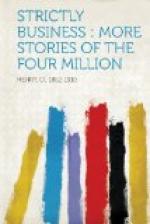“A quiet place,” I said to myself, as my first shoe struck the ceiling of the occupant of the room beneath mine. “Nothing of the life here that gives color and variety to the cities in the East and West. Just a good, ordinary, humdrum, business town.”
Nashville occupies a foremost place among the manufacturing centres of the country. It is the fifth boot and shoe market in the United States, the largest candy and cracker manufacturing city in the South, and does an enormous wholesale drygoods, grocery, and drug business.
I must tell you how I came to be in Nashville, and I assure you the digression brings as much tedium to me as it does to you. I was traveling elsewhere on my own business, but I had a commission from a Northern literary magazine to stop over there and establish a personal connection between the publication and one of its contributors, Azalea Adair.
Adair (there was no clue to the personality except the handwriting) had sent in some essays (lost art!) and poems that had made the editors swear approvingly over their one o’clock luncheon. So they had commissioned me to round up said Adair and corner by contract his or her output at two cents a word before some other publisher offered her ten or twenty.
At nine o’clock the next morning, after my chicken livers en brochette (try them if you can find that hotel), I strayed out into the drizzle, which was still on for an unlimited run. At the first corner I came upon Uncle Caesar. He was a stalwart Negro, older than the pyramids, with gray wool and a face that reminded me of Brutus, and a second afterwards of the late King Cettiwayo. He wore the most remarkable coat that I ever had seen or expect to see. It reached to his ankles and had once been a Confederate gray in colors. But rain and sun and age had so variegated it that Joseph’s coat, beside it, would have faded to a pale monochrome. I must linger with that coat, for it has to do with the story—the story that is so long in coming, because you can hardly expect anything to happen in Nashville.
Once it must have been the military coat of an officer. The cape of it had vanished, but all adown its front it had been frogged and tasseled magnificently. But now the frogs and tassles were gone. In their stead had been patiently stitched (I surmised by some surviving “black mammy”) new frogs made of cunningly twisted common hempen twine. This twine was frayed and disheveled. It must have been added to the coat as a substitute for vanished splendors, with tasteless but painstaking devotion, for it followed faithfully the curves of the long-missing frogs. And, to complete the comedy and pathos of the garment, all its buttons were gone save one. The second button from the top alone remained. The coat was fastened by other twine strings tied through the buttonholes and other holes rudely pierced in the opposite side. There was never such a weird garment so fantastically bedecked and of so many mottled hues. The lone button was the size of a half-dollar, made of yellow horn and sewed on with coarse twine.




